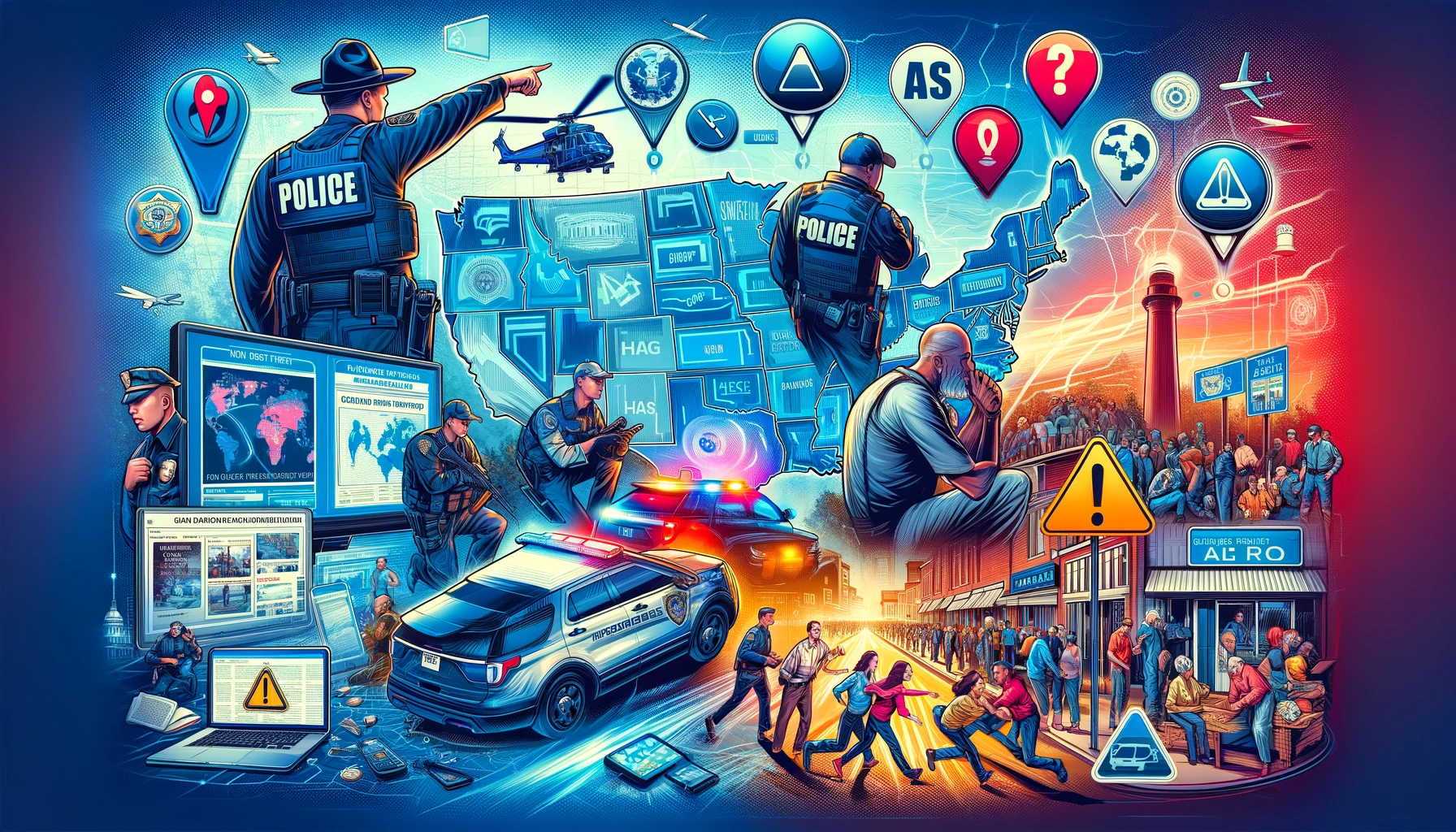Table of Contents
Introduction

Explanation of the What is Blue Alert system? – The Blue Alert system is a critical component of law enforcement communication in the United States, specifically designed to rapidly disseminate information about suspects who have killed or seriously injured law enforcement officers in the line of duty. Similar to Amber Alerts for missing children and Silver Alerts for missing seniors, the Blue Alert system serves as an urgent notification mechanism to mobilize public assistance in locating and apprehending suspects involved in attacks against law enforcement personnel.
Importance of the “What is Blue Alert” system in enhancing law enforcement safety – Law enforcement officers face inherent risks and dangers in their line of duty, and the Blue Alert system plays a vital role in mitigating these risks. By swiftly notifying law enforcement agencies, the public, and media outlets about suspects who pose a threat to officers, the Blue Alert system helps to ensure the safety of law enforcement personnel and facilitates the timely apprehension of perpetrators.
Overview of what is blue alert – the outline will cover – This blog will provide a comprehensive exploration of the Blue Alert system in the United States, delving into its origins, activation criteria, components, public notification process, impact, criticisms, and future directions. By examining the various aspects of the Blue Alert system, readers will gain a deeper understanding of its significance in enhancing law enforcement safety and its role in promoting public safety and cooperation.
What is Blue Alert System?

What is Blue Alert – Definition and Purpose – The Blue Alert system is a specialized public notification system utilized in the United States to swiftly disseminate crucial information regarding suspects who have committed serious acts of violence against law enforcement officers. Its primary purpose is to facilitate the rapid apprehension of these suspects, enhance officer safety, and prevent further harm to law enforcement personnel and the public.
What is Blue Alert – History and development in the USA – The concept of the Blue Alert system emerged as a response to the increasing number of violent attacks targeting law enforcement officers across the United States. The system’s development gained momentum in the early 2000s, spurred by advocacy from law enforcement agencies and organizations seeking additional tools to protect officers in the line of duty.
The first statewide Blue Alert system was established in Florida in 2008, following the tragic death of a Miami-Dade police officer. Since then, numerous states have implemented their own Blue Alert programs, each tailored to their specific needs and operational requirements. The system has continued to evolve, with advancements in technology and communication infrastructure enabling faster and more widespread dissemination of Blue Alerts.
What is Blue Alert – Legal framework and legislation – The implementation and operation of the Blue Alert system are supported by legislative measures enacted at both the federal and state levels. In 2015, the Rafael Ramos and Wenjian Liu National Blue Alert Act was signed into law by President Barack Obama, establishing a nationwide framework for the Blue Alert system. This legislation encourages states to develop and integrate Blue Alert programs into their law enforcement communications systems and provides support for coordination between federal, state, and local agencies.
Additionally, many states have enacted their legislation to support Blue Alerts, outlining specific criteria for issuing alerts, defining the responsibilities of participating agencies, and establishing procedures for the activation and dissemination of Blue Alerts. These legal frameworks serve to formalize and institutionalize the Blue Alert system, ensuring its effectiveness in safeguarding law enforcement officers and communities across the country.
Activation Criteria

What is Blue Alert – Circumstances triggering a Blue Alert – Blue Alerts are typically triggered by specific circumstances involving the serious injury or death of a law enforcement officer resulting from a criminal act. These circumstances may include but are not limited to, an officer being shot, stabbed, assaulted, or run over intentionally while performing their duties. The severity of the incident and the imminent threat posed by the suspect are key factors in determining whether a Blue Alert is warranted.
What is Blue Alert – Criteria for issuing a Blue Alert – The decision to issue a Blue Alert is guided by established criteria set forth by law enforcement agencies and state protocols. These criteria often include –
- Confirmation of a credible threat to law enforcement officers’ safety.
- Identification of a suspect or suspects involved in the attack on law enforcement.
- Availability of detailed information, such as suspect descriptions, vehicle descriptions, and last known whereabouts.
- Determination of an imminent danger to the public, necessitating urgent assistance in locating and apprehending the suspect(s).
- Each state may have variations in its specific criteria for issuing Blue Alerts, but the overarching goal remains consistent: to quickly disseminate critical information to law enforcement agencies and the public to aid in the swift apprehension of suspects.
What is Blue Alert – Role of law enforcement agencies in initiating a Blue Alert – Law enforcement agencies play a central role in initiating a Blue Alert once the criteria for activation are met. Upon confirmation of an incident involving the serious injury or death of a law enforcement officer, the agency responsible for investigating the incident will assess the situation to determine if a Blue Alert is warranted.
If the criteria for issuing a Blue Alert are met, the investigating agency will coordinate with state or regional Blue Alert coordinators to activate the alert. This may involve providing detailed information about the suspect(s), the vehicle involved, and any other pertinent details necessary for public dissemination.
Additionally, law enforcement agencies are responsible for assisting in the ongoing investigation, including pursuing leads generated by the Blue Alert and coordinating efforts to locate and apprehend the suspect(s) responsible for the attack on law enforcement personnel.
Components of a Blue Alert

What is Blue Alert – Description of the suspect – One of the primary components of a Blue Alert is a detailed description of the suspect(s) involved in the attack on law enforcement officers. This description typically includes identifying characteristics such as –
- Physical appearance (e.g., height, weight, hair color, eye color)
- Clothing worn at the time of the incident
- Tattoos, scars, or other distinguishing features
- Any known aliases or nicknames
Providing an accurate and comprehensive description of the suspect(s) is essential for aiding law enforcement and the public in identifying and locating the individuals responsible for the attack.
What is Blue Alert – Details about the suspect’s vehicle – In addition to describing the suspect(s), a Blue Alert will also include detailed information about any vehicles associated with the incident. This information may include –
- Make, model, and color of the vehicle
- License plate number and state
- Unique features or modifications to the vehicle
- Direction of travel and last known location
Including vehicle details in the Blue Alert allows law enforcement and the public to be on the lookout for specific vehicles associated with the suspect(s), increasing the likelihood of locating and apprehending them quickly.
What is Blue Alert – Other pertinent information included in a Blue Alert – In addition to suspect and vehicle descriptions, a Blue Alert may contain other pertinent information related to the incident, such as –
- Circumstances surrounding the attack on law enforcement officers
- Any known weapons or threats posed by the suspect(s)
- Potential locations where the suspect(s) may be headed
- Contact information for reporting sightings or providing tips to law enforcement
Including this additional information in the Blue Alert enhances its effectiveness by providing context and guidance to law enforcement and the public in responding to the situation. By presenting a comprehensive overview of the incident and the individuals involved, Blue Alerts empowers communities to assist in the apprehension of suspects and contribute to the safety of law enforcement officers and the public.
Public Notification Process

Methods of disseminating Blue Alerts to the public – The dissemination of Blue Alerts to the public relies on various communication channels to ensure widespread awareness and prompt response. Some common methods used to notify the public include –
- Emergency alert systems – Blue Alerts are broadcast through emergency alert systems, such as the Emergency Alert System (EAS) and Wireless Emergency Alerts (WEA), which can reach a large number of people through television, radio, and mobile devices.
- Highway signs – Blue Alerts may be displayed on electronic highway signs along major roadways, providing motorists with immediate information about suspects or vehicles to be on the lookout for.
- Social media – Law enforcement agencies often utilize their official social media accounts to share Blue Alerts with followers, encouraging them to share the information within their networks and communities.
- Websites and mobile apps – Blue Alerts may be posted on law enforcement agency websites and mobile applications, allowing the public to access information and updates about ongoing incidents.
What is Blue Alert – Role of media outlets in broadcasting Blue Alerts
Media outlets, including television, radio stations, newspapers, and online news platforms, play a crucial role in broadcasting Blue Alerts to the public. Law enforcement agencies collaborate with media partners to ensure the timely dissemination of Blue Alerts through news broadcasts, breaking news alerts, and online updates. Media outlets amplify the reach of Blue Alerts by reaching audiences across various demographics and geographical locations, helping to mobilize public assistance in locating suspects and vehicles involved in attacks on law enforcement officers.
What is Blue Alert – Utilization of technology and social media platforms for Blue Alert notifications
Advancements in technology and the widespread use of social media platforms have transformed the way Blue Alerts are disseminated to the public. Law enforcement agencies leverage technology and social media platforms such as Twitter, Facebook, and Instagram to rapidly share Blue Alerts with a broader audience. The real-time nature of social media enables agencies to reach a large number of people quickly, encouraging community engagement and participation in reporting sightings or providing tips to aid in the apprehension of suspects. Additionally, mobile applications and notification systems allow individuals to receive Blue Alerts directly on their smartphones, enhancing accessibility and ensuring that critical information reaches people wherever they are.
Impact and Effectiveness of What is Blue Alert

Case studies highlighting successful Blue Alert activations
Case Study 1 – Texas Blue Alert
- In 2019, a Texas Blue Alert was issued after a suspect fatally shot a state trooper during a traffic stop. The Blue Alert provided detailed information about the suspect and his vehicle to law enforcement agencies and the public.
- As a result of the Blue Alert, the suspect was quickly identified and located, leading to his apprehension within hours of the incident. The timely dissemination of information played a crucial role in the successful resolution of the case and ensured that the suspect was brought to justice.
Case Study 2 – Arizona Blue Alert
- In 2020, an Arizona Blue Alert was activated following an ambush-style attack on two police officers. The suspect fled the scene, prompting law enforcement to issue a Blue Alert with detailed descriptions of the suspect and his vehicle.
- Thanks to the Blue Alert, the suspect was spotted by a vigilant citizen who had received the alert on their mobile device. The citizen immediately contacted law enforcement, leading to the swift apprehension of the suspect without further incident.
Evaluation of the effectiveness of Blue Alerts in apprehending suspects – Blue Alerts have proven to be highly effective in aiding law enforcement agencies in the apprehension of suspects involved in attacks on officers. The rapid dissemination of critical information to law enforcement and the public has resulted in –
- Quick identification and apprehension of suspects, often within hours or even minutes of the incident.
- Enhanced cooperation between law enforcement agencies and the public, leading to increased tips and sightings reported by citizens.
- Prevention of further violence and harm to law enforcement officers and the public by swiftly removing dangerous suspects from the streets.
- Overall, the effectiveness of Blue Alerts in apprehending suspects underscores the importance of timely communication and community engagement in ensuring the safety of law enforcement personnel and the communities they serve.
Public response and awareness of the Blue Alert system
Public response to Blue Alerts has been overwhelmingly positive, with many individuals expressing appreciation for the system’s ability to quickly disseminate critical information during emergencies. The widespread adoption of Blue Alerts by law enforcement agencies and the media has contributed to increased public awareness and understanding of the system’s purpose and importance.
Through public education efforts and outreach initiatives, law enforcement agencies have worked to further raise awareness about Blue Alerts and encourage community participation in reporting sightings and providing tips. As a result, the public has become more proactive in assisting law enforcement during Blue Alert activations, demonstrating a shared commitment to promoting officer safety and public security.
What is Blue Alert – Criticisms and Challenges
Limitations and criticisms of the Blue Alert system
- Limited effectiveness in certain situations – Critics argue that the Blue Alert system may not always be effective in apprehending suspects, particularly in cases where the suspect has already fled the area or where there is limited information available for dissemination.
- Over-reliance on public cooperation – Some critics question the reliance on public cooperation in reporting sightings and providing tips, suggesting that not all members of the public may be inclined or able to assist law enforcement during Blue Alert activations.
- Potential for misuse or overuse – Concerns have been raised about the potential for misuse or overuse of Blue Alerts, which could desensitize the public to genuine emergencies and lead to complacency in responding to alerts.
Challenges faced in implementing and maintaining the Blue Alert system
- Coordination and communication: The effectiveness of the Blue Alert system relies on seamless coordination and communication between law enforcement agencies at the federal, state, and local levels. However, challenges may arise in ensuring consistent protocols and procedures across jurisdictions.
- Resource allocation: Implementing and maintaining a robust Blue Alert system requires dedicated resources, including personnel, technology, and funding. Limited resources may pose challenges in expanding the reach and capabilities of the Blue Alert system.
- Privacy and civil liberties concerns: Balancing the need for timely information dissemination with privacy considerations and civil liberties protections presents a challenge for law enforcement agencies. Ensuring transparency and accountability in the use of Blue Alerts is essential to address these concerns.
What is Blue Alert – Proposed improvements and solutions to address criticisms
- Enhanced training and education – Providing training and education to law enforcement personnel and the public on the proper use and response to Blue Alerts can help improve effectiveness and community engagement.
- Technological advancements – Leveraging advancements in technology, such as data analytics and artificial intelligence, can enhance the accuracy and timeliness of Blue Alert activations and improve the targeting of alerts to specific geographic areas.
- Public outreach and awareness campaigns – Conducting public outreach and awareness campaigns to educate the public about the purpose and importance of Blue Alerts can help build trust and cooperation among community members.
- Legislative reforms – Reviewing and updating legislation governing the Blue Alert system to address emerging challenges and concerns, such as privacy protections and misuse of alerts, can help ensure the continued effectiveness and integrity of the system.
What is Blue Alert – Comparison with Other Alert Systems
Contrasting the Blue Alert system with Amber Alerts and Silver Alerts
- Amber Alerts – Amber Alerts are issued for missing children, typically in cases where a child’s abduction poses a credible threat of serious harm or death. The primary focus of Amber Alerts is on locating and rescuing abducted children.
- Silver Alerts – Silver Alerts are issued for missing seniors, particularly those with cognitive impairments such as dementia or Alzheimer’s disease, who are at risk of harm or injury if not found promptly.
Similarities and differences in activation criteria, notification methods, and effectiveness
- Activation criteria – While the activation criteria for Blue Alerts, Amber Alerts, and Silver Alerts may differ based on the nature of the emergency (i.e., attack on law enforcement, child abduction, or missing senior), they all require confirmation of a credible threat to the individual’s safety.
- Notification methods – All three alert systems utilize various communication channels, including emergency alert systems, media outlets, social media, and digital highway signs, to disseminate critical information to the public.
- Effectiveness – Each alert system has demonstrated effectiveness in mobilizing public assistance and aiding in the swift resolution of emergencies. However, their effectiveness may vary depending on factors such as public awareness, cooperation, and the specific circumstances of the incident.
Lessons learned and potential cross-pollination of strategies between alert systems
Collaboration and coordination – There is potential for collaboration and coordination between Blue Alerts, Amber Alerts, and Silver Alerts to leverage best practices and resources across all alert systems. Sharing lessons learned and strategies for effective communication and community engagement can enhance the overall effectiveness of emergency alerting efforts.
What is Blue Alert – Targeted outreach – By conducting targeted outreach and education campaigns, alert systems can increase public awareness and participation in responding to emergencies. Engaging diverse communities and addressing specific needs and concerns can improve the reach and impact of alert notifications.
What is Blue Alert – Technological innovation – Embracing technological innovation, such as the integration of advanced data analytics and geolocation technologies, can enhance the precision and timeliness of alert activations. Leveraging emerging technologies can improve the targeting of alerts to specific geographic areas and increase the likelihood of reaching individuals who may be able to assist.
In conclusion, (What is blue Alert) while Blue Alerts, Amber Alerts, and Silver Alerts serve distinct purposes, there are opportunities for synergy and collaboration to strengthen emergency alerting capabilities and enhance public safety across all alert systems.
Future Directions and Expansion

Potential enhancements and advancements in the Blue Alert system
- Integration of advanced technology – Future enhancements to the Blue Alert system may involve the integration of advanced technology, such as artificial intelligence and machine learning algorithms, to improve the accuracy and effectiveness of alert activations. These technologies could help analyze data more efficiently, identify potential threats, and target alerts to specific geographic areas with greater precision.
- Real-time tracking and monitoring – Implementing real-time tracking and monitoring capabilities into the Blue Alert system could enable law enforcement agencies to track the movement of suspects and vehicles more effectively. This would enhance situational awareness and facilitate a coordinated response to active threats in progress.
- Enhanced public engagement – Leveraging social media platforms and mobile applications to facilitate two-way communication between law enforcement agencies and the public could enhance public engagement and participation in Blue Alert activations. Interactive features such as reporting sightings and providing tips directly through mobile devices could streamline the process of gathering information and aid in the apprehension of suspects.
Expansion of the Blue Alert system to other countries or regions
- International cooperation – Given the global nature of law enforcement challenges, there is potential for the expansion of the Blue Alert system to other countries or regions through international cooperation and collaboration. Establishing partnerships with law enforcement agencies in other countries could facilitate the exchange of best practices, information sharing, and coordinated responses to cross-border threats.
- Adaptation to local contexts – When expanding the Blue Alert system to other countries or regions, it would be essential to adapt the system to local contexts and legal frameworks. This may involve customizing activation criteria, notification methods, and public outreach strategies to align with the specific needs and requirements of each jurisdiction.
Role of technology and innovation in improving Blue Alert capabilities
- Advancements in communication technology – Continued advancements in communication technology, such as the development of 5G networks and satellite-based communication systems, could enhance the reliability and speed of Blue Alert notifications. This would ensure that critical information reaches law enforcement agencies and the public promptly, even in remote or challenging environments.
- Integration of predictive analytics – Integrating predictive analytics capabilities into the Blue Alert system could help identify patterns and trends associated with attacks on law enforcement officers. By analyzing historical data and identifying potential risk factors, law enforcement agencies could proactively identify and mitigate threats before they escalate into violence.
- Expansion of alert dissemination channels – Exploring new channels for alert dissemination, such as smart devices, smart speakers, and connected vehicles, could further expand the reach of Blue Alerts and ensure that critical information reaches individuals across a variety of platforms and devices.
In summary, the future of the Blue Alert system holds great potential for enhancements and expansions that will strengthen law enforcement safety and enhance public security both domestically and internationally. By embracing technological innovation and fostering collaboration, the Blue Alert system can continue to evolve and adapt to meet the evolving challenges of ensuring the safety of law enforcement officers and communities.
Conclusion for What is Blue Alert
Recap of the significance of the Blue Alert system in law enforcement safety – The Blue Alert system stands as a vital tool in enhancing law enforcement safety in the United States. Designed to rapidly disseminate critical information about suspects who have harmed or killed law enforcement officers, the Blue Alert system plays a crucial role in mobilizing public assistance and facilitating the swift apprehension of perpetrators. By providing timely alerts and engaging communities in the response process, the Blue Alert system contributes to the protection of law enforcement personnel and the prevention of further violence in our communities.
Summary of key points discussed in the blog outline – Throughout this exploration of the Blue Alert system, several key points have emerged –
- The Blue Alert system is a specialized public notification system used to disseminate information about suspects who have harmed or killed law enforcement officers.
- Activation criteria, components of Blue Alerts, and the public notification process are essential aspects of the system’s operation.
- Case studies highlight the effectiveness of Blue Alerts in apprehending suspects and preventing further harm.
- Criticisms and challenges, such as limitations in effectiveness and resource allocation, underscore the need for continuous improvement.
- Comparisons with other alert systems and potential future directions emphasize the importance of collaboration and innovation in enhancing law enforcement safety.
Call to action for supporting and advocating for the continued improvement of the Blue Alert system – As we reflect on the significance of the Blue Alert system and its role in protecting our law enforcement officers, we must continue to support and advocate for its continued improvement. This includes –
- Raising awareness about the Blue Alert system and its importance in safeguarding our communities.
- Supporting legislative efforts to strengthen and expand the Blue Alert system, both domestically and internationally.
- Embracing technological innovation and best practices to enhance the effectiveness and efficiency of Blue Alerts.
- Engaging in ongoing dialogue and collaboration with law enforcement agencies, policymakers, and community stakeholders to address challenges and identify opportunities for improvement.
- Together, we can work towards a safer future for law enforcement officers and communities across the United States by supporting and advocating for the continued improvement of the Blue Alert system.
FAQ’s
What is a Blue Alert?
A Blue Alert is a public notification system used to disseminate information about suspects who have killed or seriously injured law enforcement officers.
When is a Blue Alert activated?
A Blue Alert is activated when a law enforcement officer is killed or seriously injured in the line of duty, and there is a credible threat to public safety.
How does the Blue Alert system work?
The Blue Alert system rapidly disseminates information about suspects, including descriptions and vehicle details, to law enforcement agencies, media outlets, and the public to aid in apprehension.
What information is included in a Blue Alert?
A Blue Alert typically includes descriptions of the suspect(s) and their vehicle, along with any other pertinent details relevant to the incident.
Who can issue a Blue Alert?
Law enforcement agencies are responsible for initiating Blue Alerts when specific criteria, such as an officer’s death or serious injury, are met.
How are Blue Alerts disseminated to the public?
Blue Alerts are disseminated through various channels, including emergency alert systems, media outlets, social media, and digital highway signs.
What is the purpose of a Blue Alert?
The primary purpose of a Blue Alert is to enhance law enforcement safety by swiftly notifying the public and law enforcement agencies about suspects who pose a threat to officers.
Is the Blue Alert system effective?
Yes, the Blue Alert system has been effective in aiding law enforcement agencies in apprehending suspects and preventing further harm to officers and the public.
Can anyone receive Blue Alerts?
Yes, Blue Alerts are designed to reach as many people as possible, including individuals with smartphones, television viewers, and motorists traveling on highways.
How can I help during a Blue Alert activation?
If you have any information related to the Blue Alert, such as sightings of the suspect or their vehicle, you are encouraged to report it to law enforcement immediately.




